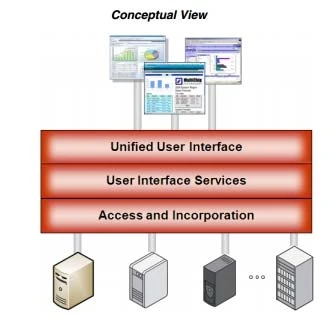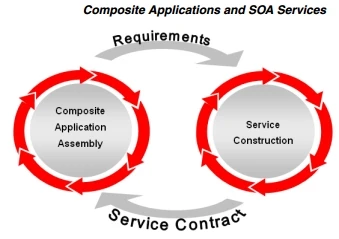Question 6 of 176
Which of the following are the key drivers for Grid computing?
Correct Answer: A, B, D
Question 7 of 176
Which of the following statements are true about an end-to-end security strategy?
Correct Answer: B, C, E
Question 8 of 176
Conceptually, the ORA model of a "modern UI" defines which three layers from the following list?
Correct Answer: A, E, F
Note:

A: The Unified User Interface layer provides the control and visual elements that define the interaction the user has with the system. This layer separates the way the user interacts with the system from the underlying functionality provided by the system.
This has many advantages including allowing different display devices to be supported via control and visual elements specialized for the device since, for example, mobile devices do not have nearly the screen real estate of a desktop computer.
E: The User Interface Services layer provides a set of functionality that can be used and reused in a variety of ways to deliver various user interfaces specialized to the needs of the end user. This illustrates that the underlying functionality is separated from the visual and control elements built into the user interface. The services provided by this layer may come from a variety of sources located anywhere that is network accessible.
F: The Access and Incorporation layer provides the capability to incorporate data and functionality from any number of backend systems into the user interface.
Generally, there are two types of backend systems that need be incorporated into the user interface: systems that are designed for use with user interface (e.g.
LDAP, dedicated database) and systems that are not (e.g. legacy applications). The former type systems can be access directly by the user interface architecture. Ideally the latter type should be accessed via a robust integration architecture rather than relying on point-to-point integrations.
This distinction is the reason that the term "incorporation" is used in this Conceptual View instead of the term "integration." A suitable integration architecture is described in the ORA Service-Oriented Integration document.
Reference: Oracle Reference Architecture, User Interaction, Release 3.0 AEF

A: The Unified User Interface layer provides the control and visual elements that define the interaction the user has with the system. This layer separates the way the user interacts with the system from the underlying functionality provided by the system.
This has many advantages including allowing different display devices to be supported via control and visual elements specialized for the device since, for example, mobile devices do not have nearly the screen real estate of a desktop computer.
E: The User Interface Services layer provides a set of functionality that can be used and reused in a variety of ways to deliver various user interfaces specialized to the needs of the end user. This illustrates that the underlying functionality is separated from the visual and control elements built into the user interface. The services provided by this layer may come from a variety of sources located anywhere that is network accessible.
F: The Access and Incorporation layer provides the capability to incorporate data and functionality from any number of backend systems into the user interface.
Generally, there are two types of backend systems that need be incorporated into the user interface: systems that are designed for use with user interface (e.g.
LDAP, dedicated database) and systems that are not (e.g. legacy applications). The former type systems can be access directly by the user interface architecture. Ideally the latter type should be accessed via a robust integration architecture rather than relying on point-to-point integrations.
This distinction is the reason that the term "incorporation" is used in this Conceptual View instead of the term "integration." A suitable integration architecture is described in the ORA Service-Oriented Integration document.
Reference: Oracle Reference Architecture, User Interaction, Release 3.0 AEF
Question 9 of 176
A longer term goal of Service-Oriented Integration (SOI) is to enable composite applications that are assembled from SOA Services. Which statement best describes the relationship between composite application assembly and SOA Service engineering?
Correct Answer: C
The Oracle Service Engineering Framework is an engineering approach for delivering projects within an SOA environment
The Service Engineering Framework addresses activities at both the program and project scope to consider the requirements of the business outside of the scope of a single project.
Topics covered at the program scope include:
* SOA Requirements Management - Provides a process for harvesting requirements in a manner that naturally facilitates service identification and discovery.
* Service Identification & Discovery - Establishes the procedures around identifying Service candidates, as well as discovering reuse candidates from the existing
Service catalog. Takes the process from identification and discovery, through the justification processes required to determine if an existing Service can be viable for reuse in the proposed manner, or if the proposed Service Candidate should be realized as a shared Service.
* Service Release Planning - Provides the groundwork necessary for planning for project and Service deliveries within an SOA
Topics covered at the project scope include:
* Service Definition -
* Service Design -
* Service Implementation - Provides the guidelines for effectively and efficiently developing shared Services.
* Service Testing -
* Service Deployment - Defines the guidelines and practices that need to be considered when deploying Services into a shared environment.
* Service OA&M -
Note:
The primary goal of service-oriented integration is to better leverage existing system within the IT environment by applying service-oriented principles. Ultimately, the goal is to enable the assembly of composite applications, with little or no custom coding, that include capabilities sourced from existing systems. Composite applications are applications that pull together data, functionality, and process from multiple existing sources to solve a business problem or create new business value.
Service-oriented integration is the mechanism to expose existing sources of data, functionality, and process so that those sources can be readily consumed by a composite application C

The Oracle Service Engineering Framework is an engineering approach for delivering projects within an SOA environment
The Service Engineering Framework addresses activities at both the program and project scope to consider the requirements of the business outside of the scope of a single project.
Topics covered at the program scope include:
* SOA Requirements Management - Provides a process for harvesting requirements in a manner that naturally facilitates service identification and discovery.
* Service Identification & Discovery - Establishes the procedures around identifying Service candidates, as well as discovering reuse candidates from the existing
Service catalog. Takes the process from identification and discovery, through the justification processes required to determine if an existing Service can be viable for reuse in the proposed manner, or if the proposed Service Candidate should be realized as a shared Service.
* Service Release Planning - Provides the groundwork necessary for planning for project and Service deliveries within an SOA
Topics covered at the project scope include:
* Service Definition -
* Service Design -
* Service Implementation - Provides the guidelines for effectively and efficiently developing shared Services.
* Service Testing -
* Service Deployment - Defines the guidelines and practices that need to be considered when deploying Services into a shared environment.
* Service OA&M -
Note:
The primary goal of service-oriented integration is to better leverage existing system within the IT environment by applying service-oriented principles. Ultimately, the goal is to enable the assembly of composite applications, with little or no custom coding, that include capabilities sourced from existing systems. Composite applications are applications that pull together data, functionality, and process from multiple existing sources to solve a business problem or create new business value.
Service-oriented integration is the mechanism to expose existing sources of data, functionality, and process so that those sources can be readily consumed by a composite application C
Question 10 of 176
What are the benefits of the browser over traditional user Interfaces (for example, client-server GUI)?
Correct Answer: B, C, F